 |
Image Deformation Using Moving Least Squares
Schaefer S., McPhail T. and Warren J.
To appear in ACM SIGGRAPH 2006
Abstract: We provide an image deformation method based on Moving Least Squares using various
classes of linear functions including affine, similarity and rigid transformations.
These deformations are realistic and give the user the impression of manipulating
real-world objects. We also allow the user to specify the deformations using either
sets of points or line segments, the later useful for controlling curves and
profiles present in the image. For each of these techniques, we provide simple
closed-form solutions that yield fast deformations, which can be performed in
real-time.
|
 |
A Unified, Integral Construction For Coordinates Over Closed Curves
Schaefer S., Ju T. and Warren J.
To appear in Computer-Aided Geometric Design 2006
Abstract: We propose a simple generalization of Shephard's interpolation to piecewise smooth,
convex closed curves that yields a family of boundary interpolants with linear
precision. Two instances of this family reduce to previously known interpolants: one
based on a generalization of Wachspress coordinates to smooth curves and the other
an integral version of mean value coordinates for smooth curves. A third instance of
this family yields a previously unknown generalization of discrete harmonic
coordinates to smooth curves. For closed, piecewise linear curves, we prove that our
interpolant reproduces a general family of barycentric coordinates considered by
Floater, Hormann and Kos that includes Wachspress coordinates, mean value
coordinates and discrete harmonic coordinates.
|
 |
Building 3D surface networks from 2D curve networks with application to anatomical modeling
T. Ju, J. Warren, J. Carson, G. Eichele, C. Thaller, W. Chiu, M. Bello and I. Kakadiaris
Proceedings of Pacific Graphics, to appear, 2005
We present a novel method that automatically constructs
a surface network from curve networks with arbitrary
topology and partitioning an arbitrary number of materials.
The surface network exactly interpolates the curve
network on each plane and is guaranteed to be free of gaps
or self-intersections. In addition, our method provides a flexible
framework for user interaction so that the surface topology
can be modified conveniently when necessary. As an application,
we applied the method to build a high-resolution
3D model of the mouse brain from 2D anatomical boundaries
defined on 350 tissue sections.
|
 | |
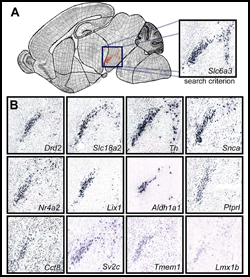 |
A Digital Atlas to Characterize the Mouse Brain Transcriptome
J. Carson, T. Ju, H. Lu, C. Thaller, M. Xu, S. Pallas, M. C. Crair, J. Warren, W. Chiu and G. Eichele
PLoS Computational Biology, to appear, 2005
Here we have developed a computational method for annotating gene expression patterns in the context
of a digital atlas to facilitate custom user-queries and comparisons of this type of data.
This procedure has been applied to 200 genes in the postnatal mouse brain.
As an illustration of utility, we identify candidate genes that may be related to Parkinson's disease by
using the expression of a dopamine transporter in the substantia nigra as a search query pattern.
In addition, we discover that transcription factor Rorb is down-regulated in the barrelless mutant relative
to control mice by quantitative comparison of expression patterns in layer IV somatosensory cortex.
|
 | |
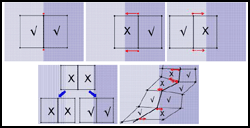 |
Hybrid Segmentation Framework for Tissue Images Containing Gene Expression Data
M. Bello, T. Ju, J. Warren, J. Carson, W. Chiu, C. Thaller, G. Eichele and I. Kakadiaris
Proceedings of MICCAI, to appear, 2005
In this work, we propose a new automatic method that results in the segmentation of
gene expression images into distinct anatomical regions in which the expression
can be quantified and compared with other images. Our method utilizes models of
shape of training images, texture differentiation at region boundaries, and features
of anatomical landmarks to deform a subdivision mesh-based atlas to fit gene expression
images.
|
 | |
 |
Mean Value Coordinates for Closed Triangular Meshes
Ju T., Schaefer S. and Warren J.
ACM SIGGRAPH 2005, pages 561-566
Abstract: Constructing a function that interpolates a set of values
defined at vertices of a mesh is a fundamental operation in computer
graphics. Such an interpolant has many uses in applications such
as shading, parameterization and deformation. For closed polygons,
mean value coordinates have been proven to be an excellent method
for constructing such an interpolant. In this paper, we generalize
mean value coordinates from closed 2D polygons to closed
triangular meshes. Given such a mesh P, we show that these
coordinates are continuous everywhere and smooth on the interior
of P. The coordinates are linear on the triangles of P and can
reproduce linear functions on the interior of P. To illustrate
their usefulness, we conclude by considering several interesting
applications including constructing volumetric textures and
surface deformation.
|
 | |
 |
A Geometric Construction of Coordinates for Convex Polyhedra using Polar Duals
Ju T., Schaefer S., Warren J., Desbrun M.
Eurographics Symposium on Geometry Processing 2005, pages 181-186
Abstract: A fundamental problem in geometry processing is that of expressing
a point inside a convex polyhedron as a combination of the
vertices of the polyhedron. Instances of this problem arise often
in mesh parameterization and 3D deformation. A related problem
is to express a vector lying in a convex cone as a non-negative
combination of edge rays of this cone. This problem also arises in
many applications such as planar graph embedding and spherical
parameterization. In this paper, we present a unified
geometric construction for building these weighted combinations
using the notion of polar duals. We show that our method yields a
simple geometric construction for Wachspress's barycentric
coordinates, as well as for constructing Colin de Verdiere
matrices from convex polyhedra---a critical step in Lovasz's
method with applications to parameterizations.
|
 | |
 |
Dual Marching Cubes: Primal Contouring of Dual Grids
Schaefer S. and Warren J.
Proceedings of Pacific Graphics 2004, pages 70-76
Abstract: We present a method for contouring an implicit function
using a grid topologically dual to structured grids such as octrees.
By aligning the vertices of the dual grid with the features of the
implicit function, we are able to reproduce thin features without
excessive subdivision required by methods such as Marching Cubes or
Dual Contouring. Dual Marching Cubes produces a crack-free,
adaptive polygonalization of the surface that reproduces sharp
features. Our approach maintains the advantage of using structured
grids for operations such as CSG while being able to conform to the
relevant features of the implicit function yielding much sparser
polygonalizations than has been possible using structured grids.
|
 | |
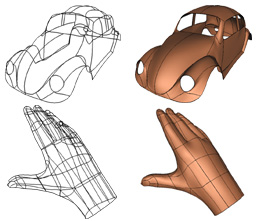 |
Lofting Curve Networks using Subdivision Surfaces
Schaefer S., Warren J. and Zorin D.
Eurographics Symposium on Graphics Processing 2004, pages 105-116.
Abstract: Lofting is a traditional technique for creating a curved shape by
first specifying a network of curves that approximates the desired
shape and then interpolating these curves with a smooth surface.
This paper addresses the problem of lofting from the viewpoint of
subdivision. In particular, we develop two new subdivision
schemes; a univariate scheme that converges to a network of cubic
splines and a modified Catmull-Clark scheme that lofts these curve
networks. Near the curve network, these lofted subdivision
surfaces are C^2 except for those points where three or more
curves meet at which the surface is C^1 with bounded curvature.
As a demonstration of these two methods, we have constructed an
automatic system that quadrangulates these curve networks using a
novel method and fairs the surfaces produced by our subdivision
scheme.
|
 | |
 |
Smooth Subdivision of Tetrahedral Meshes
Schaefer S., Hakenberg J. and Warren J.
Eurographics Symposium on Graphics Processing 2004, pages 151-158.
Abstract: We describe a new subdivision scheme for unstructured tetrahedral meshes.
Previous tetrahderal schemes based on generalizations of box splines
have encoded arbitrary directional preferences in their associated subdivision rules
that were not reflected in tetrahderal base mesh. Our method avoids this
choice of preferred directions resulting a scheme that is simple to implement
via repeated smoothing. In an extended appendix, we analyze this tetrahedral scheme
and prove that the scheme generates C^2 deformations everywhere except along edges
of the tetrahedral base mesh. Along edges shared by four or more tetrahedra in the
base mesh, we present strong evidence that the scheme generates C^1 deformations.
|
 | |
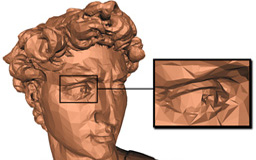 |
Adaptive Vertex Clustering Using Octrees
Schaefer S. and Warren J.
Proceedings of SIAM Geometric Design and Computing 2003, pages 491-500.
Abstract: We present an adaptive vertex clustering approach to out-of-core
simplification of polygonal meshes using a dynamic octree. Similar to uniform
clustering, our technique utilizes quadratic error functions to position the mesh
vertices; however, this new method can resolve vertices to arbitrary resolutions,
which allows reproduction of extremely small details and more accurate
simplifications. By sorting the vertices of the input mesh, our algorithm
dynamically discovers portions of the mesh that are locally complete, which are
then available for collapse when the octree grows too large. This adaptive octree
is then used to cluster the vertices of the input to generate a simplified mesh.
Finally, we show that our method generates the same tree that would be constructed
with unbounded memory if our method is given a small amount of space in addition
to the size of the output tree.
|
 | |
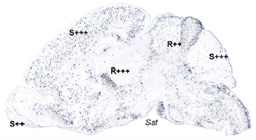 |
Automated Characterization of
Gene Expression Patterns with an Atlas of the Mouse Brain
Carson J., Ju T., Thaller C., Warren J., Bello M., Kakadiaris I., Chiu W. and Eichele G.
To appear in EMBS (2004).
A spatio-temporal map of gene activity in the brain would be an important contribution to the
understanding of brain development, disease, and function. Such a resource is now possible using
high-throughput in situ hybridization, a method for transcriptome-wide acquisition of cellular
resolution gene expression patterns in serial tissue sections. However, querying an enormous
quantity of image data requires computational methods for describing and organizing gene
expression patterns in a consistent manner. In addressing this, we have developed procedures for
automated annotation of gene expression patterns in the postnatal mouse brain.
|
 | |
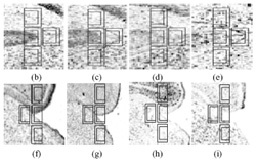 |
Landmark-driven, Atlas-based Segmentation
of Mouse Brain Tissue Images Containing Gene Expression Data
Kakadiaris I., Bello M., Arunachalam S., Kang W., Ju T., Warren J., Carson J., Chiu W., Thaller C. and Eichele G.
To appear in MICCAI (2004).
Associating specific gene activity with specific functional locations in the brain anatomy
results in a greater understanding of the role of the gene's products. To perform such an
association for a large amount of data, reliable automated methods that characterize the
distribution of gene expression in relation to a standard anatomical model are required. In
this paper, we present an anatomical landmark detection method that has been incorporated
into an atlasbased segmentation. The addition of this technique significantly increases the
accuracy of automated atlas-deformation. The resulting large-scale annotation will help
scientists interpret gene expression patterns more rapidly and accurately.
|
 | |
 |
On C^2 Triangle/Quad Subdivision
Schaefer S. and Warren J.
ACM Transactions on Graphics, Vol 24, No. 1 (2005), pages 28-36.
This paper describes a subdivision scheme for triangle/quad surfaces that is C^2 everywhere except at extraordinary points where the surface is C^1. The subdivision rules we describe are the same as Stam/Loop's triangle/quad paper except that we apply a preprocessing "unzippering" pass to the mesh, which increases the smoothness on triangle/quad edges from C^1 to C^2. The scheme is practical in that it can be applied to arbitrary meshes including non-manifold meshes.
|
 | |
 |
Smooth Geometry Images
Losasso F., Hoppe H., Schaefer S. and Warren J.
Eurographics Symposium on Geometric Processing (2003), pages 138-145.
This paper generalizes Hoppe's previous work on geometry images
to the smooth case. The paper includes an elegant example of
this method used to provide continuous level of detail.
|
 | |
 |
A Geometric Database for Gene Expression Data
Ju T., Warren J., Eichele G., Thaller C., Chiu W. and Carson J.
Eurographics Symposium on Geometric Processing (2003), pages 166-176.
This paper describes an application of subdivision meshes
to the problem of building a deformable atlas for the mouse
brain. In particular, we show that subdivision meshes are
ideally suited for building a database that supports queries
comparing gene expression data.
|
 | |
 |
Barycentric Coordinates for Convex Sets
Warren J., Schaefer S., Hirani A. and Desbrun M.
To appear in Advances in Computational and Applied Mathematics
This paper superceeds a technical report that we wrote on barycentric coordinates.
In particular, we extend the discrete coordinates from Warren 1996 to the continuous
case of a convex region bounded by a smooth manifold in arbitrary dimensions. We provide
a proof of linear precision for these coordinate functions and describe their application to
boundary value problems and freeform deformation.
|
 | |
 |
On the Uniqueness of Barycentric Coordinates
Warren J.
Contemporary Mathematics, Proceedings of AGGM02 (2003).
Given a convex polytope with m facets in d dimensions, this
paper proves there is exactly one set of rational barycentric
coordinates for this polytope of degree m-d. These coordinates
are exactly the coordinates described in Warren 1996.
|
 | |
 |
A Factored Approach to Subdivision Surfaces
Schaefer S. and Warren J.
Computer Graphics & Applications, Vol. 24, No. 3 (2004), pages 74-81
This paper is an invited tutorial on the basic of
subdivision. Read this paper if you want a non-mathematical
introduction to subdivision.
|
 | |
 |
Teaching Computer Game Design and Construction
Schaefer S. and Warren J.
Submitted to a special issue of Computer-Aided Design (2003)
This paper describes the author's experience in teaching
a senior-level computer gaming class here at Rice University.
The paper is written as a how-to manual for others that
wish to design and teach such a class.
|
 | |
 |
Convex Contouring of Volumetric Data
Ju T., Schaefer S. and Warren J.
The Visual Computer, Vol. 19, No. 7-8, (2003), pages 513-525
This paper desribes a variant of Marching Cubes that generates
contours whose negative space is convex inside each cube. This
property is then exploited to build an extremely fast collision detection
method.
|
 | |
 |
Dual Contouring: "The Secret Sauce"
Schaefer S. and Warren J.
Rice University Technical Report
This tech report gives a more detailed description of our implementation
of dual contouring. The key technique is a description of how to manipulate
and minimize QEFs.
|
 | |
 |
Dual Contouring of Hermite Data
Ju T., Losasso F., Schaefer S. and Warren J.
ACM Transactions on Graphics, Vol. 21, (2002), pages 339-346.
This paper introduces a new contouring method that combines
a dual method such as SurfaceNets with the sharp feature
reproduction of Extended Marching Cubes. The paper
includes an elegant algorithm for adaptive contouring.
|
 | |
 |
A smooth subdivision scheme for hexahedral meshes
Bajaj C., Schaefer S., Warren J. and Xu G.
The Visual Computer, Vol. 18, 2002, pages 409-420.
This paper describes a trivariate subdivision scheme for hexahedral meshes. The scheme consists of linear subdivision followed by an averaging phase. The scheme converges to a C^2 volume meshes almost everywhere except along extraordinary edges where the scheme is provably C^1 and at extraordinary vertices where the authors supply strong experimental evidence that the scheme is still smooth.
|
 | |
 |
A subdivision scheme for surfaces of revolution
Morin G., Warren J. and Weimer H.
Computer-Aided Geometric Design, Vol. 18, 2001, pages 483-502.
This paper describes a simple generalization of the Catmull-Clark subdivision scheme that is capable of exactly reproducing surfaces of revolution.
|
 | |
 |
Subdivision schemes for fluid flow
Weimer H. and Warren J.
SIGGRAPH 99 conference proceedings, pages 111-120.
This paper describes a vector subdivision scheme that, given a coarse vector field, converges to continuous vector that approximates the original coarse vector field and approximately satisfies the partial diffirential equations for various types of linear flow.
|
 | |
 |
Edge and vertex insertion for a class of C^1 subdivision surfaces
Habib A. and Warren J.
Computer-Aided Geometric Design, 16 (1999), pages 223-247.
This paper describes a generalization of the C^1 four direction quadratic box-spline to arbitrary topologies. Additional rules are given that allow "sharp" features to be inserted into these splines in a manner analogous to that of quadratic B-splines.
|
 | |
 |
Subdivision schemes for thin plate splines
Weimer H. and Warren J.
Proceedings of Eurographics, Computer Graphics Forum, Vol. 17, No. 3, 1998, pages 303-313 & 392.
This paper derives a subdivision scheme that converges to locally supported approximations to thin plate splines.
|
 | |
 |
Subdivision schemes for variational splines
Weimer H. and Warren J.
Approximation theory IX (1998), pages 345-352.
This paper illustrates the relation between variational problem and subdivision schemes. Specifically, the solution space to a wide range of variational problems can be captured as a spline space defined through subdivision.
|
 | |
 |
Multi-resolution analysis for surfaces of arbitrary topological type
Lounsbery M., DeRose T. and Warren J.
ACM Transactions on Graphics, Vol. 16, No. 1, 1997, pages 34-73.
This paper describes a general method for doing multi-resolution analysis over irregular geometry. The key building block is to define scaling functions over irregular geometry via subdivision.
|
 | |
 |
Sparse filter banks for binary subdivision schemes
Warren J.
Mathematics of surface VII (1996).
This paper describes a simple, local method for building sparse synthesis and analysis filters given a sequence of binary subdivision matrices. These filters banks can used as the building blocks for multi-resolution analysis.
|
 | |
 |
Barycentric coordinates for convex polytopes
Warren J.
Advances in Computational Mathematics, Vol. 6, No. 2, 1996, pages 97-108.
This paper gives a general construction for a special type of coordinate system over a convex polytope. This barycentric coordinate system has a set of coordinate functions, one per vertex, that are nonnegative over the polytope, sum to one, and reproduce linear functions.
|
 | |
 |
An Efficient Evaluation Algorithm for Polynomials in the Polya Basis
Warren J.
Computing, Vol. 24, 1995, pages 1-5.
This paper discuss an extension of Newton's method for
evaluating polynomials in the monomial basis to the more
general Polya basis.
|
 | |
 |
Binary subdivision scheme for functions over irregular knot sequences
Warren J.
Mathematical Methods in CAGD III, (1995)
This paper describes and analyzes univariate subdivision schemes over irregular spacings.
|
 | |
 |
Multi-sided rational surfaces patches with independent boundary control
Warren J.
Design and Application of Curves and Surfaces: Mathematics of Surfaces V (1994), pages 281-294.
This paper analyzes several schemes for building surface patches with more that four sides. The common theme shared by these schemes is the rational coordinates functions must have singularities at well-defined locations.
|
 | |
 |
Factoring Rational Polynomials over the Complex Numbers
Bajaj C., Canny J., Garrity T. and Warren J.
SIAM Journal of Computing, Vol. 22, No. 2, 1993.
This paper describes a clever method for factoring
polynomials using geometric techniques.
|
 | |
 |
An Extension of Chaiken's Algorithm to B-Spline Curves with Knots in Geometric Progression
Goldman R. and Warren J.
Computer Graphics, Vision, and Information Processing, Vol. 55, No. 1, 1993, pages 58-61.
This paper discusses a simple clever modification of Chaikin's
algorithm to allow subdivision of B-spline whose knots lie in
geometric progression.
|
 | |
 |
Creating Multi-Sided Rational Bezier Surfaces using Base Points
Warren J.
ACM Transactions on Graphics, Vol. 11, No. 2, 1992, pages 127-139.
This paper describes a technique for creating extra sides on a rational
Bezier patch by setting the weights of corner control points to zero. This
technique can be used to understand the behavior of Gregory patches.
|
 | |
 |
A Bound on the Implicit Degree of Polygonal Bezier Surfaces
Warren J.
Algebraic Geometry and Applications (1991).
This paper gives a simple constructive proof of the implicit degree
of multi-sided rational Bezier patches with a given Newton polygon.
|
 | |
 |
Subdivision methods for geometric design
Warren J.
A monograph on subdivision written in 1994 that formed an initial draft
for the subsequent book Subdivision Methods For Geometric Design: A Constructive Approach, published by Morgan Kaufmann in 2002.
|


 Contact Info
Contact Info Publications
Publications Papers
Papers Talks
Talks